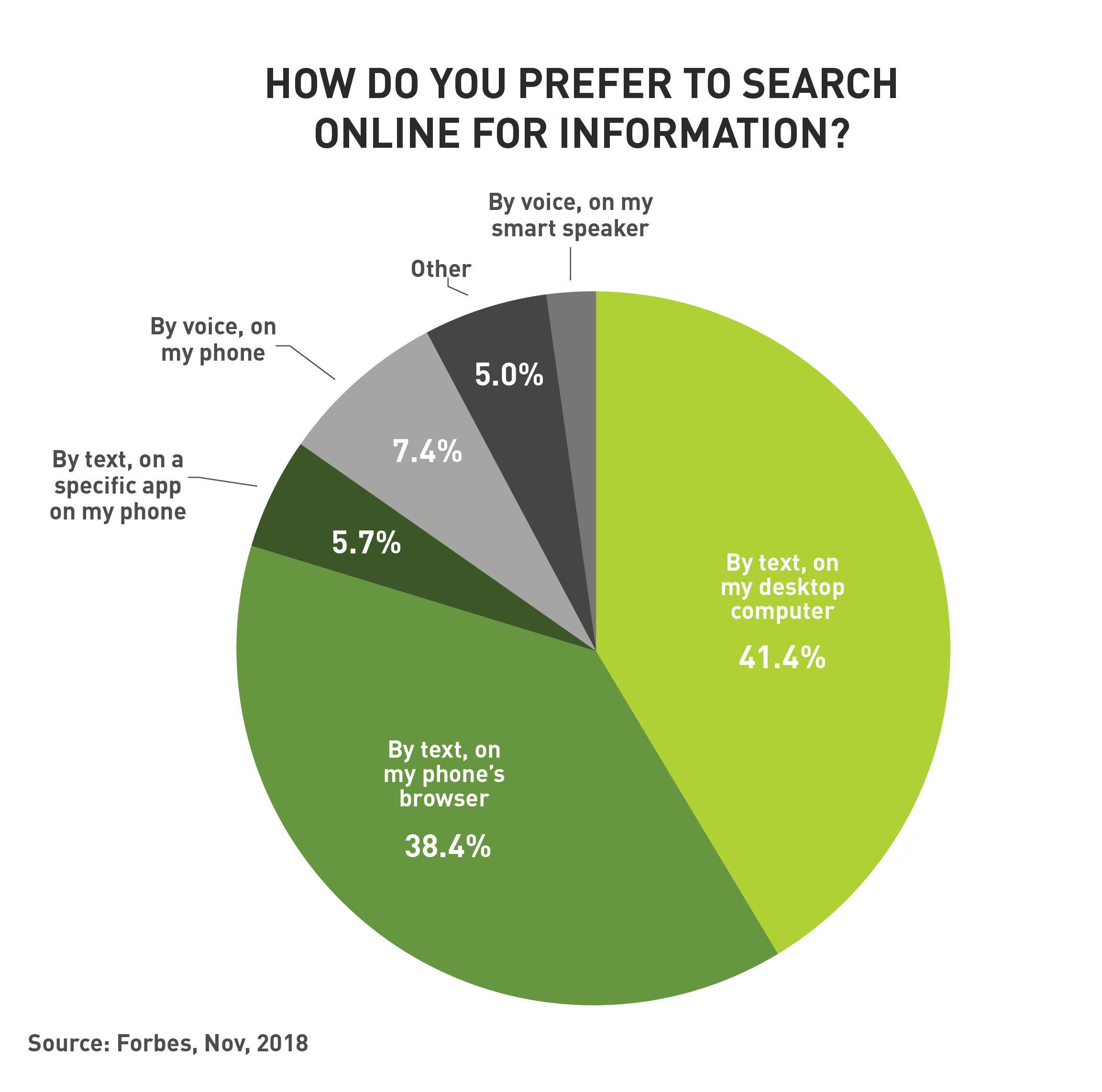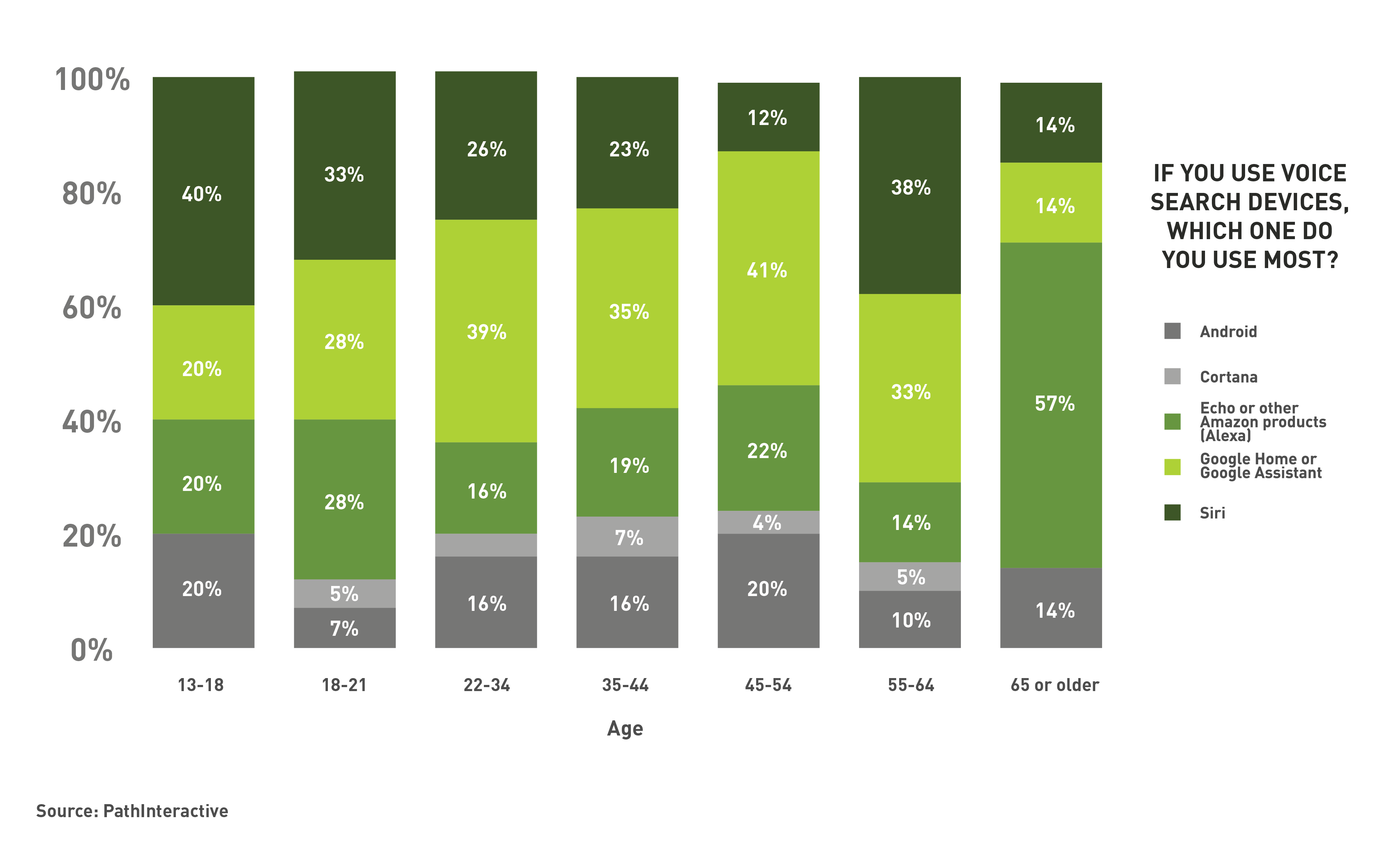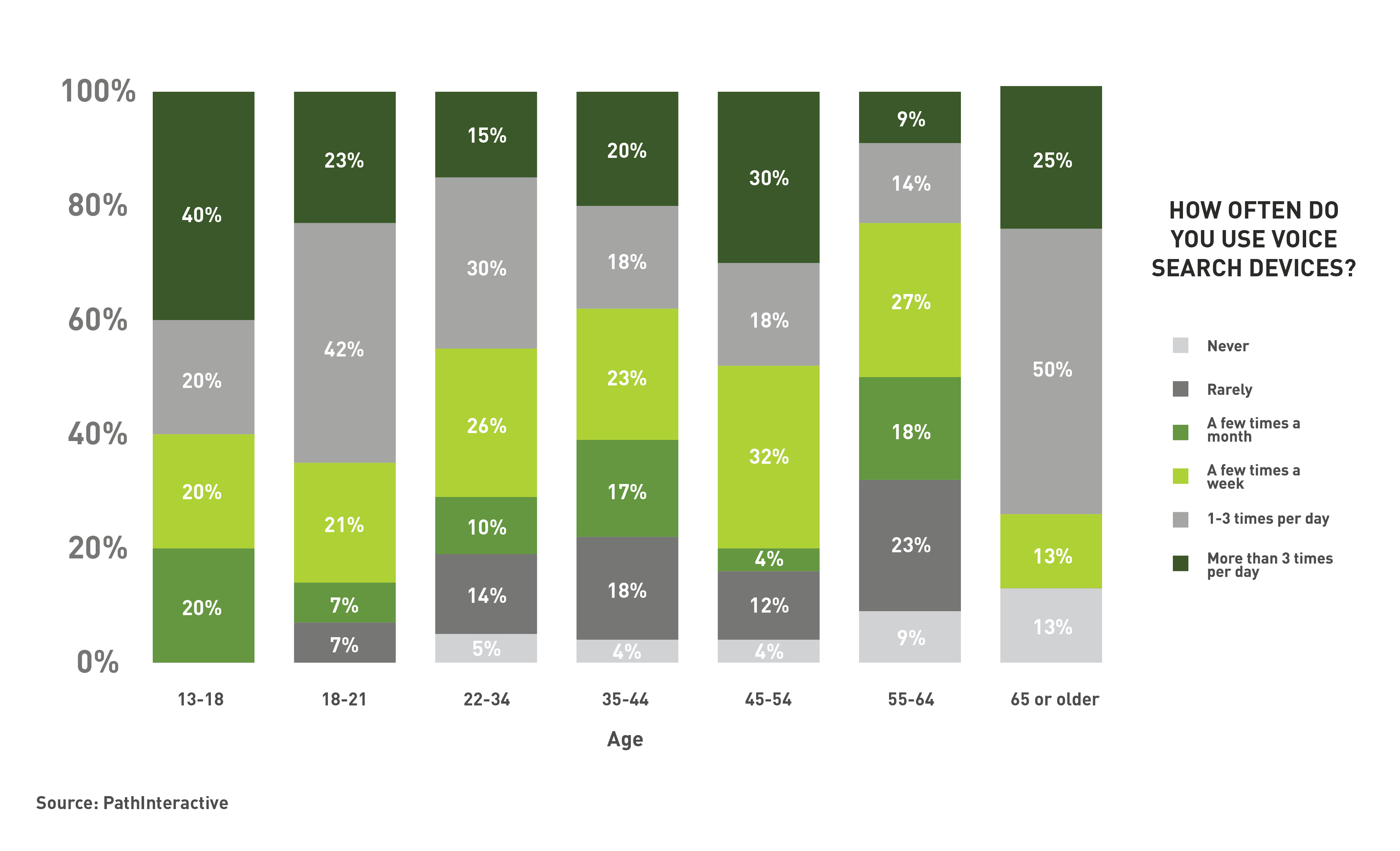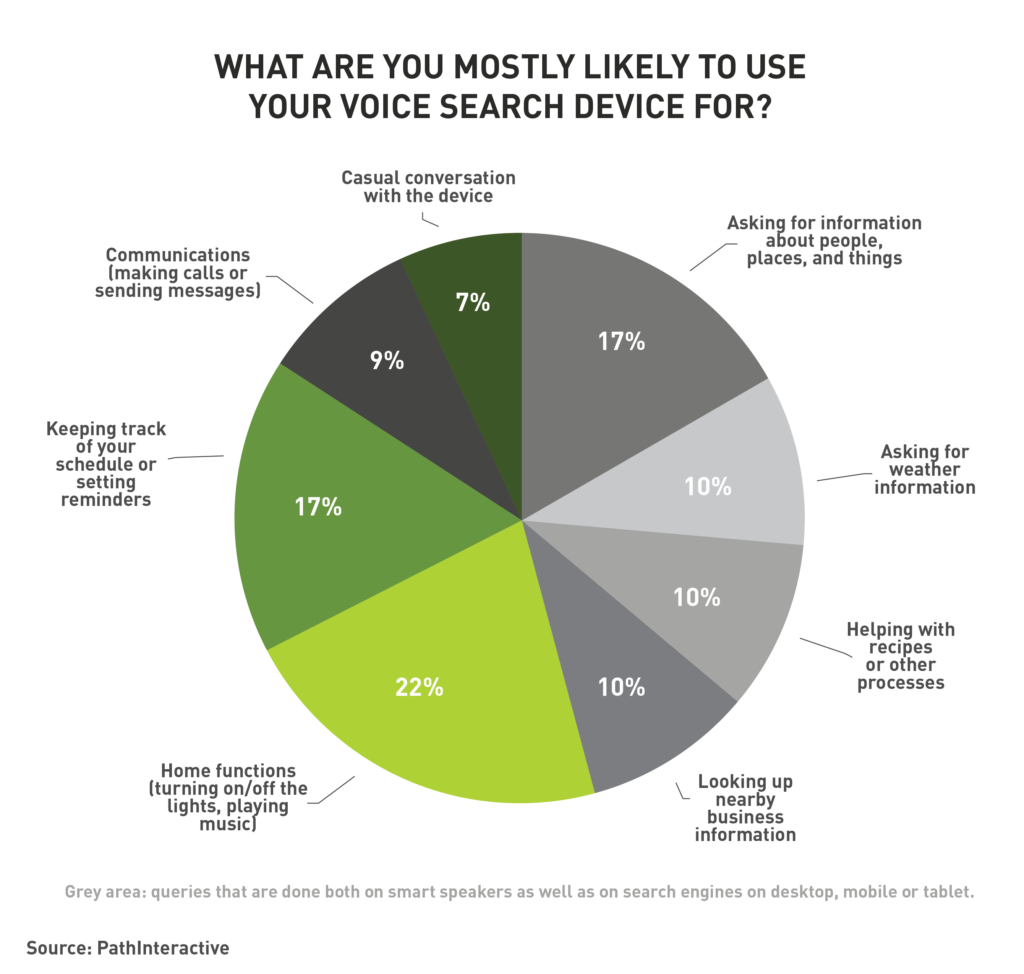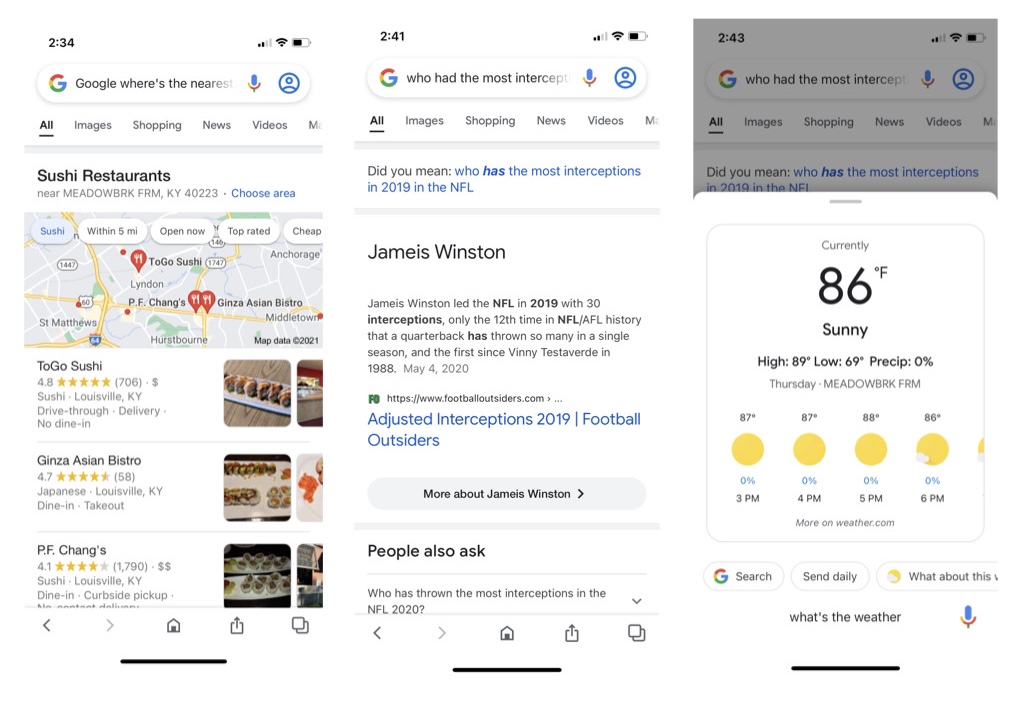In a September 2014 interview with Fast Company, Andrew Ng, Chief Scientist at Baidu went on the record to state that in five years he anticipated 50% of searches on Chinese search engine, Baidu, would be image or voice searches. This prediction was concentrated into an article, which implied that “in five years, at least 50% of all searches are going to be either through images or speech both in China and on Baidu.“
Then in 2017, Comscore noted in a recent study that 50% of smartphone users had admitted using voice search (at all) and that 1 in 3 of surveyed adults noted using voice search daily. Somehow between Baidu’s stat in 2014 and ComScore’s stat in 2017, a bit of an urban myth was born. By misquoting these statistics, predictions were made that “by 2020, 50% of all online searches would be voice searches.” In today’s Plain Talk, we’ll look at the ensuing panic this faux statistic created, and then separate fact from myth to get to the bottom of just how important voice search is to your business.
The Voice Panic
Quickly, versions of this fake statistic started popping up in hundreds of blog articles and even some reputable industry trade magazines (sorry Campaign) and lists across the globe. Agencies and clients alike were in a full-panic, cramming to prepare for an anticipated tsunami of voice traffic that did not really materialize. In fact, in the midst of this flurry of activity, Forbes reported that only 13% of adults preferred voice search over text.
But the trend predictions, especially those about IoT and voice search, continued to press advertisers and agencies to “get ready for voice.” Even today, that mythical 50% statistic continues to be batted around as bloggers and journalists continue to assert that voice is becoming preeminent. But is it really? Here’s what we know.
What Percentage of Search is Actually Voice?
This may come as a shock, but WE DON’T KNOW because (as of this writing) this figure is not reported by Google and Google owns 92.5% of all searches. So, if they don’t report it, we don’t know. In fact, we don’t think anyone has ever publicly confirmed what percentage of overall search volume is conducted using voice. But here’s what we do know:
1. In 2016, Google reported that 20% of its mobile searches were voice and that this number was growing. This stat has not been updated since 2016.
2. We know from numerous sources that while IoT device (mostly smart speakers) ownership is growing, the majority of voice search is on mobile devices using virtual assistants like Siri and Google Voice. In 2016, roughly 60% of users reported using a virtual assistant for the first time over the previous year. So, it’s safe to assume that voice search on mobile has increased some since 2016 but again, we do not know how much.
3. Because voice search is primarily mobile, we can also assign some weight to the fact that there has been significant growth in the percentage of overall search volume that is mobile. Today, mobile and tablet search makes up more than 51% of all searches versus less than 40% in 2016. It seems safe to say that some of that mobile growth will have been voice.
4. Finally, the overall proportion of adults who report using voice search (at all, ever) is growing. It is safe to assume this percentage continues to increase as data supports the growth of things like smart speakers. However, Google reported in 2018 that 27% of the population was at least occasionally using voice search on mobile.
So rather than making crazy unsubstantiated claims to scare you, we think it’s safe to say that voice search enjoys modest but growing use among internet users.
Who Uses Voice Search?
The answer is most of us, some of the time! In a 2020 Perficient Survey, when asked to list their most likely ways to ask a question on a smartphone, using voice finished in fourth place, behind typing into search engine apps (75%), opening up a browser (72%), and typing into the search window on their phone (63%). Still, 55% of the smartphone respondents included voice searches as one of their top answers. This means that at least 55% of us are using voice search at least part of the time.
Who Uses Voice Most?
According to a 2019 Path Interactive Study, of 620 respondents ages 13-85 from the U.S. (57.4%), India (21.6%), Europe (11.4%), Canada (4.1%), children and seniors are most likely to use voice search, only on different devices. Seniors are fans of Alexa and Children Siri. Also, voice search – probably due to convenience – is more popular with women.
What are People Voice Searching for?
According to the same 2019 Path Interactive Study, 55% of voice requests are non-search related. Home functioning purposes and scheduling topped the list.
The voice request searches are highly local. In 2018, BrightLocal found that 46% of voice search users look for a local business on a daily basis and according to a SCORE 2019 study, consumers use voice search for these tasks:
- 54% make a restaurant reservation
- 46% determine prices of a local business’s products/services
- 40% ask which products a business has in stock
- 32% buy directly from a business
Why Do People Use Voice Search?
According to Semrush, the two main reasons people use voice search are that it’s faster and it’s situationally convenient. Situationally convenient means they’re doing something that might otherwise keep them from typing, such as driving or taking a bath.
What’s Different About Voice Search?
Alexa, Siri and Google are all activated by voice commands, and we’re inherently programmed to talk to them like they are people. We ask them questions revolving around “who,” “what,” “why,” “where” and “how much.” Not surprisingly, when people use voice search, their questions/queries average 6.5 words versus 1-3 words in typed searches.
This means that you need to optimize for long-tail search terms that are questioning sentences in structure. This can best be addressed by writing the copy in a question/answer format. Some companies find that this can best be addressed on their Q&A pages. In a recent blog article, Neil Patel visualizes how this Q&A approach to long-tail might look for the root-term flights.
Voice and Non-Click SERP
Voice and non-click SERP fit hand-in-hand. Again, the two main reasons people use voice search are speed and situational convenience. They are likely doing something like looking for a sushi restaurant while at a stoplight, settling an argument about who threw the most interceptions in 2019 or wondering what the weather is. The search engine results pages (SERP) may include a map and reviews, or a stat pulled from reference site, or the weather graphic displayed over the search window.
It’s not surprising that mobile organic click-thru rates in the U.S. dropped from 58.43% in 2016 to 38.97% in 2018, when voice and non-click SERP swelled in popularity, while desktop organic click-thru rates remained stable and only increased slightly from 65.56% to 65.72%. At the same time, smart speaker sales are growing fast with 150 million units shipping in 2020 alone.
Should My Company Make Optimizing for Voice A Priority?
To win in marketing today is to win in digital marketing as part of an increasingly common omnichannel approach. While voice search itself is still heating up, we think now is a great time to optimize and gain the SERP benefits that already exist.
1. We are confident that Google’s algorithms favor sites that are optimized for voice and by optimizing for voice, then your SERP will improve. Why? Well, things like page speed are pretty important to SERP because faster pages offer Google users a better experience. According to Backlinko, the average voice search result page loads in 4.6 seconds (52% faster than the average page). In their SEO study, Backlinko also notes a number of other performance improvements with voice optimization that Google likes, including a preference for steering users to non-click search results, something voice does well.
2. We know today that some of our favorite 25-49-year-old affluent consumers are most likely to use voice search. Optimizing now can give your company an advantage in engaging these consumers the way they want to be engaged.
3. For businesses who rely on local brick-and-mortar retail, like a restaurant, movie theater or hair salon, you can disproportionately benefit from voice optimization.
So, What Should You Do First?
Another reason we thought the panic mongering over voice search was unwarranted was that many of the things you need to do to optimize your site for voice are things you should already be doing to optimize your site for text search, as well as good customer experience and non-click SERP relevance. Of course, if you are not currently optimized for organic search, you’re not just unprepared to maximize voice search business, you’re missing out on the bulk of text search in your category. That’s money lost. So, consider these first steps:
1. Ask and answer questions. Address your copy to provide FAQ long-tail answers that will be easy for search engines to find, as addressed above. The least disruptive way to do this is by beefing up your FAQs. Start here!
2. Be fast. Make your site lightning fast! Target against Google Core Web Vital Standards. In rare fashion, Google announced these standards as official ranking factors, and has made them a requirement for “Top Stories,” which are a critical component of non-click SERP.
3. Make page authority a priority! Because non-click SERP – oftentimes driven by voice search – increases convenience and speed, it makes being on page two even less relevant than it was before! There is nothing new here, just an increased realization that the SEO rich will get richer, and the SEO poor will get poorer as voice continues to gain in popularity. Now is the time to double down on your page authority efforts.
4. HTTPS – duh! Although Google made HTTPS a ranking factor in 2014, in 2021, more than 45% of websites still don’t have SSL certificates. This is a quick and easy fix. Do it NOW!
5. Design mobile first! Most voice search and non-click searches are mobile or screenless.
6. Make sure you’re optimized for local. GoogleMyBusiness needs to be up-to-date. Remember Alexa uses Bing. Optimize for Bing Local too. Additionally, as you build more long-tail search terms be sure to localize them.
Now Breathe
Hopefully, we’ve helped separate the facts from the myths so that you can put together an educated plan for maximizing SERP including voice. Voice search and non-click search are important disruptors. We think optimizing for voice, even if voice is currently likely only a small piece of your traffic, is still good business because everything you do to optimize for voice will likely increase your non-voice organic traffic too. If you have some questions about voice, SEO optimization, or maybe want us to have a look at your site for some evaluation, you can drop us a note here or just call us at 502-499-4209, and we’ll be happy to help.



